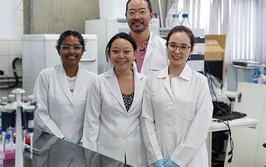Unraveling Art with Analysis
SORS meets microscopy to delve deeper into historical art and sculptures

In the past, we’ve explored how analytical techniques can uncover the secrets of paintings by probing beyond what we see with the naked eye (tas.txp.to/0815/portrait), but what about getting beneath thicker layers of paint at the micrometer scale? A collaboration of researchers from the UK’s Science & Technology Facilities Council (STFC) and the Italian National Research Council’s Institute for the Conservation and Valorization of Cultural Heritage (ICVBC) have developed a technique that they refer to as a “new Raman imaging modality” – microscale spatially offset Raman spectroscopy (micro-SORS).
“Traditional SORS extends the access of Raman spectroscopy to greater depth within diffusely scattering (turbid) samples. However, one limitation remained – SORS was unable to probe and resolve micrometer-scale layers in highly turbid materials,” says Pavel Matousek, a STFC Senior Fellow. “Due to micrometer-scale laser illumination and Raman collection areas, and spatial offset dimensions, micro-SORS can readily resolve thin turbid layers that are beyond the reach of both traditional SORS and conventional Raman microscopy.”
Matousek began working with ICVBC in 2010, after a conservations scientist from the institute, Claudia Conti, approached him when she heard about his work. “One of the topical issues in conservation science is how to obtain chemical information in a non-destructive and non-invasive way. Many such methods available today provide only partial information on the chemical elements so new technologies are needed to achieve full characterization of the concealed compounds,” says Conti. “Our research efforts with Pavel and his team ultimately lead to the successful transformation of macro-SORS, enabling its application in the cultural heritage area and the successful demonstration of micro-SORS.”
So far, the technique has been demonstrated successfully on both painted sculptures and mural paintings. According to Conti, the most interesting findings came after analyzing the polychrome sculptures originate from the “Sacred Mounts” (UNESCO World Heritage sites) in North Italy. “They consist of a series of chapels containing wall paintings and terracotta or stucco sculptures representing the life of Christ. Due to their religious value, these sculptures were often re-painted to enhance the polychromy, thus their stratigraphy is extremely complex mainly due to the presence of multiple layers. Micro-SORS allowed us to discriminate the pigments used and their position from the surface to the more internal portions,” says Conti.
The research collaboration is also investigating the applicability of the technique in other areas, such as polymer sciences, biology and forensics, as well as working on the optimization of the technique both theoretically and experimentally. “Our Monte Carlo simulations indicate that there is a major scope for further improvement of the performance, in terms of penetration depth and sensitivity. The last but not least step is the development of a portable micro-SORS device that can be brought to the art itself,” says Matousek.
"Making great scientific magazines isn’t just about delivering knowledge and high quality content; it’s also about packaging these in the right words to ensure that someone is truly inspired by a topic. My passion is ensuring that our authors’ expertise is presented as a seamless and enjoyable reading experience, whether in print, in digital or on social media. I’ve spent seven years writing and editing features for scientific and manufacturing publications, and in making this content engaging and accessible without sacrificing its scientific integrity. There is nothing better than a magazine with great content that feels great to read."

















